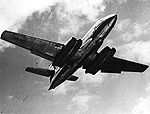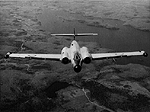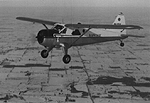
Avro Canada CF-105 Arrow
© National Aviation Museum (Canada)
Immediately after the war, commercial aviation mushroomed. From nine million passengers worldwide in 1945, the number climbed to 24 million in 1948. The widespread introduction of jet transport beginning in the late 1950s created a revolution in speed, comfort, and efficiency similar to that of the first modern airliners in the 1930s.

Avro Canada CF-105 Arrow
© National Aviation Museum (Canada)
Most Canadians are aware that, for a brief period before the program's cancellation in 1959, the supersonic Avro Canada CF-105 Arrow interceptor made this country a world leader in jet fighter aircraft. Few Canadians know, however, that Canada had established similar leadership in jet airliners, with the Avro Canada C-102 Jetliner.

Avro Canada C.102 Jetliner
© National Aviation Museum (Canada)
When it took off for the first time on August 10, 1949, the Jetliner
was the first jet transport to fly in North America; it was only two weeks
behind the first in the world, the British de Havilland Comet. Within a
few flights, the Jetliner exceeded 800 km/h, whereas the most advanced
transports of the day achieved about 450 km/h.
With the advent of the Korean War, the Canadian government ordered Avro
Canada to concentrate on production of the CF-100 interceptor. The
prototype Jetliner made its last flight in November 1956, after which it
was cut up and sold for scrap.
The CF-100, first flown
in January 1950, met a happier fate. The only one of Avro Canada's jets
to reach production, it was considered the best all-weather fighter of
its day and was used by the RCAF and the Canadian Armed Forces until the
last one was retired in 1981.

Avro Canada CF-100 Mk.5 Canuck (100757)
© National Aviation Museum (Canada)
The Korean War was the first time jet fighters met in combat. In the
air, it was essentially a duel between the American F-86 Sabre and the
Soviet MiG 15. They both have the swept-wing design developed from German
research during World War II.
Although the MiG was in some ways superior, the final score in Korea was
800 MiGs lost, 78 Sabres lost. Pilot training and experience made the difference.
Unlike the North Koreans, many of the allied pilots were World War II veterans.
Canadair acquired the licence to build the F-86. Later, it developed the
Sabre 6 powered by the
more powerful Canadian-designed Orenda engine, which gave it even better
performance.
The RCAF flew them from the early fifties to 1962. It was their Golden
Age. Sabre 6 pilots walked tall knowing they flew one of the best fighter
aircraft in the world. For three years running they won the NATO air-to-air
gunnery prize, defeating crack teams from five countries, including Britain,
Germany and the United States.
In 1953, flying a Canadair Sabre, Jaquelin Cochran proved she had the "right
stuff" by setting a new women's speed record and becoming the first
woman pilot to break the sound barrier. Her wing man on that occasion was
Chuck Yeager, the first pilot to fly faster than Mach One, the speed of
sound.
The RCAF eventually replaced the Sabre with the Lockheed
CF- 104, also known as the Starfighter. It could fly at twice
the speed of sound. Called the Missile-with-a-man-in-it, the Wingless Wonder
and Silver Sliver, it set many world records for speed, altitude and climbing
time.

Lockheed F-104A Starfighter
© National Aviation Museum (Canada)
It was flown by our squadrons in Europe with NATO. At home, the one
you are looking at set the Canadian altitude record in centennial year
1967.
In interceptors like the CF-104, pilots no longer had to get on the tail
of the enemy. They did not even need to see an enemy aircraft except on
radar. Missiles did the rest.
The outstanding success of the Canadian aviation industry in the postwar
period is the Beaver, first
flown in 1947. The Beaver is also the precursor of de Havilland Canada's
advanced short take-off-and-landing (STOL) aircraft, such as the Dash
7.

de Havilland DHC-7 Dash 7
© National Aviation Museum (Canada)
Many innovations found in the Beaver were based on the answers to a questionnaire de Havilland Canada sent to bush operators across the country. The result? Just the best small utility aircraft in the world. Its all-metal structure was a first for Canadian-designed bush aircraft. Its effective wing and flap design gave it excellent STOL performance. The floor hatch and wide doors handled rolled-in fuel drums, saving time and money.

de Havilland DHC-2 Beaver
© National Aviation Museum (Canada)
In 1950 and 1951 the U.S. Air Force and Army held competitions for aircraft
of this type. The Beaver won over thirteen American entries. It was the
first time a foreign-built aircraft had been purchased in peacetime for
the U.S. military; the U.S. forces ordered more than 900. Operators in
62 countries bought the Beaver.
The Beaver operated in the Middle East, high in the Andes and in the polar
regions. A lake, an island and a glacier in Antarctica are named Beaver
after this rugged little flyer.
The aircraft also served in Korea and Vietnam, dropping supplies and evacuating
casualties. In Korea they were the favourite "taxis" of the top
brass and were known as the Generals' Jeep. Not widely publicized is the
fact that in Korea they also made excellent ice-cream machines! They churned
the ingredients by flying tight circles in the winter sky.
Eventually, the Beaver became the most numerous of all Canadian-designed
aircraft with 1,691 manufactured. Hundreds of Beavers are still flying
more than 50 years after the first one took off. The museum's specimen
is the prototype Beaver, acquired in 1980 after almost 33 years of rugged
flying.